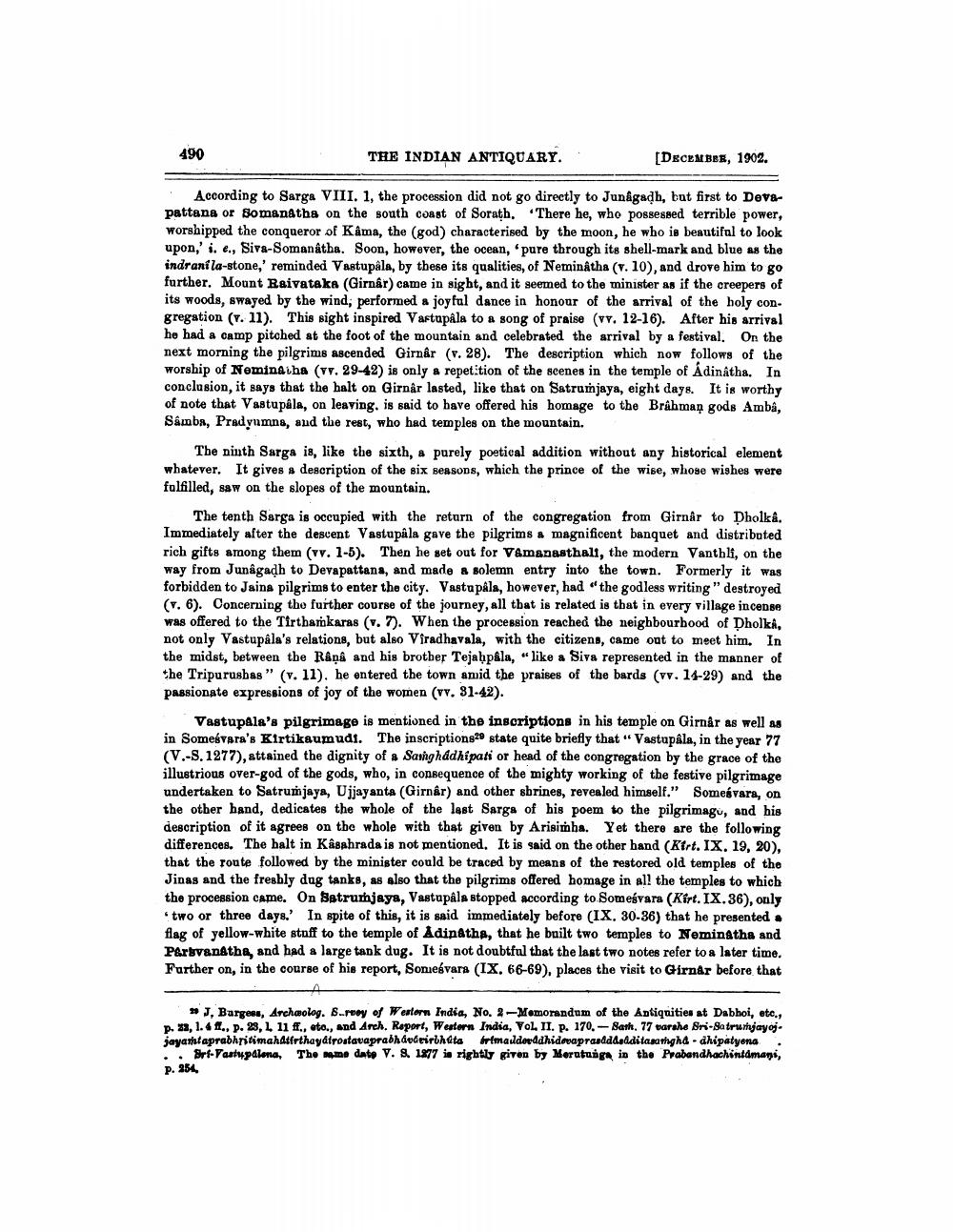________________
490
THE INDIAN ANTIQUARY.
[DECEMBER, 1902.
According to Sarga VIII. 1, the procession did not go directly to Junagadh, but first to Devapattana or Somanatha on the south coast of Sorath. There he, who possessed terrible power, worshipped the conqueror of Káma, the (god) characterised by the moon, he who is beautiful to look upon,' i. e., Siva-Somanatha. Soon, however, the ocean, pure through its shell-mark and blue as the indranila-stone,' reminded Vastupåla, by these its qualities, of Neminátha (v. 10), and drove him to go further. Mount Raivataka (Girnar) came in sight, and it seemed to the minister as if the creepers of its woods, swayed by the wind, performed a joyful dance in honour of the arrival of the holy con. gregation (v. 11). This sight inspired Vastupala to a song of praise (vv. 12-16). After his arrival he had a camp pitched at the foot of the mountain and celebrated the arrival by a festival. On the next morning the pilgrims ascended Girnar (v. 28). The description which now follows of the worship of Neminatha (vv. 29-42) is only a repetition of the scenes in the temple of Adinatha. In conclusion, it says that the halt on Girnår lasted, like that on Satramjaya, eight days. It is worthy of note that Vastupala, on leaving, is said to have offered his homage to the Brahman gods Amba, Sambs, Pradyumna, and the rest, who had temples on the mountain.
The ninth Sarga is, like the sixth, a purely poetical addition without any historical element whatever. It gives a description of the six seasons, which the prince of the wise, whose wishes were fulfilled, saw on the slopes of the mountain.
The tenth Serga is occupied with the return of the congregation from Girnår to Dholka. Immediately after the descent Vastupala gave the pilgrims a magnificent banquet and distributed rich gifts among them (vv. 1-5). Then he set out for Vamanasthall, the modern Vanthli, on the way from Junagadh to Devapattana, and made & Bolemn entry into the town. Formerly it was forbidden to Jaina pilgrims to enter the city. Vastupala, however, had "the godless writing" destroyed (v. 6). Concerning the further course of the journey, all that is related is that in every village incense was offered to the Tirthamkaras (v.7). When the procession reached the neighbourhood of Dholka, not only Vastupâla's relations, but also Vîradhavala, with the citizens, came out to meet him. In the midst, between the Râna and his brother Tejahpala, like a Siva represented in the manner of the Tripurusbas" (v. 11). he entered the town amid the praises of the bards (vv. 14-29) and the passionate expressions of joy of the women (vv. 81-42).
Vastupala's pilgrimage is mentioned in the inscriptions in his temple on Girnar as well as in Somebvara's Kirtikaumudi. The inscriptions2 state quite briefly that "Vastupala, in the year 77 (V.-S. 1277), attained the dignity of Sanghadhipati or head of the congregation by the grace of the illustrious over-god of the gods, who, in consequence of the mighty working of the festive pilgrimage undertaken to Satrumjaya, Ujjayanta (Girnar) and other shrines, revealed himself." Somesvara, on the other hand, dedicates the whole of the last Sarga of his poem to the pilgrimagu, and his description of it agrees on the whole with that given by Arisinha. Yet there are the following differences. The halt in Kâsahrada is not mentioned. It is said on the other hand (Kirt. IX. 19, 20), that the route followed by the minister could be traced by means of the restored old temples of the Jinas and the freshly dog tanks, as also that the pilgrims offered homage in all the temples to which the procession came. On Batrumjaya, Vastapâle stopped according to Someśvara (Kirt. IX. 36), only
two or three days.' In spite of this, it is said immediately before (IX. 30-36) that he presented . flag of yellow-white stuff to the temple of Adinatha, that he built two temples to Neminatha and ParbvanAtha, and had a large tank dug. It is not doubtful that the last two notes refer to a later time. Further on, in the course of his report, Sonieśvara (IX. 66-69), places the visit to Girnar before that
* J. Burgess, Archaolog. Burney of Western India, No. 2-Memorandum of the Antiquities at Dabhoi, etc., p. 32, 1.4 11., p. 23, L 11 ff., eto., and Arch. Report, Western India, Vol. II. P. 170.-- San. 77 varshe Sri-Sa trunjayoj. jayantaprabhritimahAtfrthayatrostavaprabhavaririhita frimauderddhidmapraadddsaditasonghd. dhipatyona .. Brf-Vastupalona. The nome date V. 8. 1877 is rightly given by Moratungs in the Prabandhachintamani, p. 254




